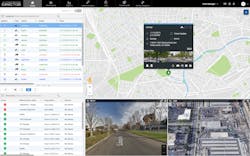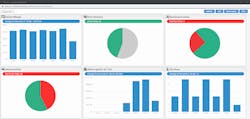Leveraging data to reduce trucking's COVID-19 angst
As COVID-19 cases continue to mount in the U.S., commercial vehicle fleets are experiencing productivity challenges on both ends of the spectrum. Fleets delivering essential goods are seeing new, unprecedented levels of demand, while others have experienced reduced productivity and have had to make difficult business decisions through the course of the pandemic.
Traffic congestion has decreased significantly, essentially eliminating the difference between weekday and weekend traffic in most major cities, according to fleet telematics provider Geotab. The downside to that is risky driving patterns among commercial truckers are on the rise, creating even greater safety challenges for fleets.
To help navigate some of the new obstacles brought on by COVID-19, fleet managers can leverage the data coming off electronic logging devices, transportation management systems (TMS) and telematics solutions to operate more efficiently during this time of uncertainty.
In response to COVID-19, Geotab has been continuously monitoring transportation and trade activity and sharing that information in weekly blog posts. Geotab also compiled a heat map, which reveals the decrease in commercial transportation activity in the U.S. ranges from as low as 58% activity in areas like New York and New Jersey to 86% activity in Central states such as Iowa, Kansas, Missouri, Nebraska).
Mike Branch, vice president of data and analytics at Geotab, pointed out that heavy-duty trucks have been the least impacted in terms of their utilization and activity. In addition, when examining commercial transportation activity to and from commercial, industrial, retail, warehouses, and grocery store locations, Geotab found that activity to and from grocery stores decreased the least, at just under 90% of baselined volumes.
As traffic congestion has decreased throughout the pandemic, the morning and evening rush hour has virtually disappeared, Geotab noted. However, commercial transportation speeds in major cities have increased. In New York City, for instance, average weekday speeds for commercial fleets have risen by 20%, according to Geotab experts.
“As speed has increased in cities, we have also seen an increase in harsh braking, hard acceleration and hard cornering as measured by daily events per active vehicle — predominantly by trucks,” Branch explained.
He added that there are ways fleets can utilize data to operate more efficiently right now. For fleets deemed an essential service, managers can help their drivers by setting up alerts to inform drivers when they are stopped in high-risk zones, or COVID-19 “hotspots.”
John Flynn, CEO of Fleet Advantage, explained that additional concerns right now include any potential delays in new equipment delivery. For certain fleets, this can impact their ability to respond to the increased supply chain demand within their vertical, such as grocery deliveries to supermarkets.
What’s more, fleets are currently challenged with proper staffing for their repair shops and back-office operations. Most back-office operations can be performed remotely, but maintenance and repairs need to be completed in the shop.
“Maintenance and repair (M&R) is traditionally a large area of expense for fleets, and given the current circumstances, additional M&R expenses from trucks that are not properly maintained can further erode a fleet’s financial picture in a time when the economic situation has placed great strain on fleets, their drivers, and certainly the financial health of the organization,” Flynn said.
Driver safety
As the safety and well-being of drivers are a top priority, fleet owners and managers can use data to take an anonymous pulse on their drivers’ health and spot potential risk areas to help ensure they are running a safe fleet.
The companies delivering critical goods and services are likely to be driving long hours, and drivers are potentially being overworked, according to Kevin Aries, head of global product success at Verizon Connect.
“They are carrying a heavy burden, and that can result in potential safety issues. Continue to monitor fleets and make sure they are driving as safely as possible,” he said.
Branch added that in-demand fleets can use fleet-wide health surveys, safety reports and customized safety rules to help ensure the health and safety of their drivers. Plus, managers can enable drivers to practice social distancing by automating customer notifications upon delivery or completion of service.
“Fleets need to ensure that their drivers are safe, with secure places to eat and take breaks and rest along with having a process to clean and disinfect the trucks at the end of each trip,” Flynn emphasized. “There also needs to be a process in place to thoroughly clean each truck’s cabin when drivers change shifts while operating the same vehicle.”
Geolocation and resource utilization
Fleet management software provider Teletrac Navman tracks data from a variety of fleets — from long-haul trucking to school buses to oil and gas. According to Sid Nair, Teletrac Navman’s senior director of product development, the COVID-19 health crisis is both the “best of times and worst of times” when it comes to customer productivity.
Right now, some fleets are using this crisis as an opportunity to realize where they are underutilized, so they can reallocate assets and resources as needed, he said.
“If they have trucks that are idle, they are getting alerted, and they are using that knowledge with the opportunity knowledge that is coming from the load boards and saying, ‘OK, I have two trucks that are running empty. We can combine that data and move those trucks to where the jobs are,’” Nair explained. “They are trying to geolocate, so larger fleets with more than one base are trying to coordinate and see where they should be deploying their resources.”
The biggest challenge right now is that drivers must remain on the road during the pandemic.
Nair emphasized it is of utmost importance that fleets clearly utilize data to make intelligent decisions for their drivers — like making sure drivers are close to home, safe and able to return home when they can. It is also important that dispatchers can work from home and that all employees are able to work and stay connected with the organization. Of equal importance is for fleets to remain connected with their end customers, he explained.
“Every time I talk to someone and ask them what they think is going to happen in the next month or more no one knows. There is a bit of uncertainty,” Nair said. “I think many people are holding off on making major decisions right now. I haven’t seen this level of uncertainty in the last six years that I have been doing telematics work.”Geotab’s Branch recommended that fleets focus on key utilization metrics and macro-level trends, such as insights to help the industry understand current trends in transportation and trade activity.
“Utilization metrics should be monitored and tracked longitudinally against their baseline (i.e. number of stops per day and total distance traveled). This data allows fleet managers to understand how their business is operating at a regional level,” he added. “These insights could help inform hiring strategy, business operations and more. It will help fleets identify where activity is still consistent or where it's increasing, enabling fleets to respond to unprecedented changes and allowing for new opportunities or business partnership to arise.”
On a short-term basis, location is key, noted Aries. He, too, reiterated this is important in terms of resource utilization.
“We know the businesses that are operating are doing so with lower staffing due to various reasons, including sick time,” Aries said. “So, having better visibility of your fleet is going to give you the best opportunity to make the critical choices you need in terms of allocating the right people to the right jobs.”
On a longer-term basis, data experts urge fleet managers to look at where their revenue streams have been reduced. That means having a good grasp on how their fleet and delivery activity today compares to what it was at the start of the pandemic.
Prepping for the aftermath
Right now, one of the biggest challenges for fleets is not knowing what is next or how to plan for the future.
“In general, this is just a great time for businesses to be looking more at data as a whole,” he added. “Many companies say they don’t have time to look at data and optimize their business. There has never been a better time to really think about how to take business to the next level.”
Fleet Advantage’s Flynn noted the importance of remaining focused on the larger picture, with long-term business strategies in mind.
“Proactive fleets that may have been considering modernizing their fleet and updating their equipment will realize that this is an opportune time to be analyzing the age of their assets and plan for the recovery,” he explained. “A recovery will take place, and fleets should recognize that pent-up demand will eventually be realized, and fleets will need to be prepared to accommodate with updated equipment that offer advanced safety features.”
Flynn added that it’s also important for fleets to be as flexible as possible with their own business models.
“With the closing of restaurants especially, many food distributors need to reallocate their trucks and resources to help with the demand on the grocery side,” Flynn explained. “We are aware that this has created a shift in some fleets and the way they approach their own business and driver programs. For example, we are working with fleets that are suddenly in need of additional trucks to help keep up with increased capacity demand. These are immediate needs and the structure of the deal needs to be flexible to meet their immediate demand, but also allow them to return the asset when the impact of the current circumstances return to normal, which is an unknown at this point.”
About the Author

Cristina Commendatore
Cristina Commendatore is a past FleetOwner editor-in-chief. She wrote for the publication from 2015 to 2023.




